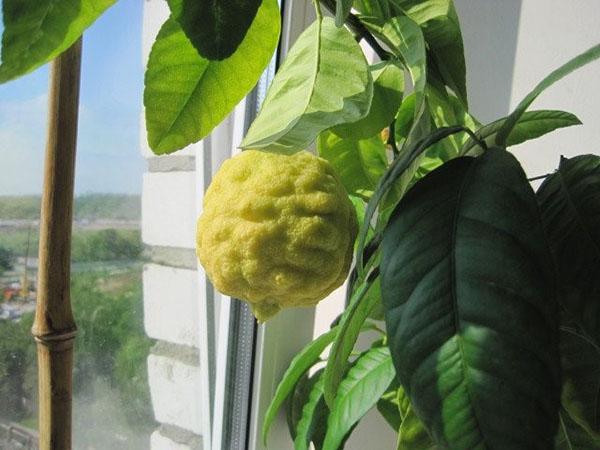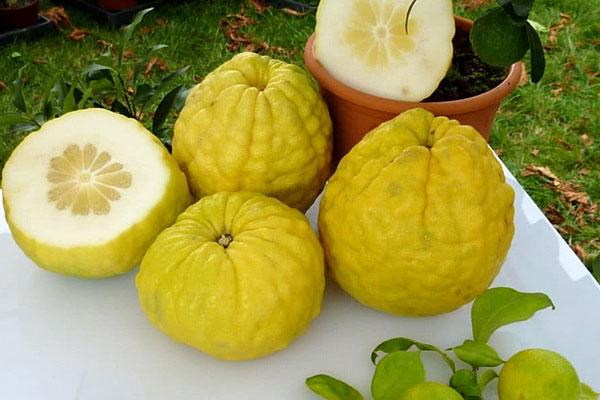Exotic citron at home: the painstaking process of growing a plant
 The exotic fruits of an unusual plant will be a wonderful decoration for an apartment and diversify the family's diet. Growing citron at home is a snap. However, getting a crop to bear fruit is a difficult task. Since citruses are very warm and light-loving, they require special conditions for keeping. Nevertheless, breeders have developed special varieties of this species, which are adapted to the "harsh" climate of city apartments.
The exotic fruits of an unusual plant will be a wonderful decoration for an apartment and diversify the family's diet. Growing citron at home is a snap. However, getting a crop to bear fruit is a difficult task. Since citruses are very warm and light-loving, they require special conditions for keeping. Nevertheless, breeders have developed special varieties of this species, which are adapted to the "harsh" climate of city apartments.
How to plant citron at home

In order to provide the citron plant with flowering, in winter the tree is taken to a cool room (10 ... 15 )С). In the autumn and winter periods, the flowerpot requires additional lighting.
What is citron? It is a fruit from the citrus family that looks like lemon... However, its rind is very thick, so it is difficult to separate it from the pulp. Some varieties of citron have a bizarre shape and resemble a human hand. 
When the place for the decorative tree is chosen, you can start planting it. To do this, take a stalk, cut in the spring from a one-year-old branch, and cleaned of leaves. Its length should be no more than 15 cm. It is important to leave 2-4 shoots in its upper part.
Next, prepare the soil substrate, which should consist of:
- turf (2 parts);
- leafy ground (2 hours);
- sand (1 part);
- humus (1 hour);
- wood ash (at the discretion of).
Drainage in the form of expanded clay must be placed at the bottom of the pot. The layer thickness should not be less than 2 cm. Such a base will protect the citron plant from moisture stagnation.
 The proposed composition can be slightly changed. To do this, you will have to mix 2 parts of sand with humus and black earth (1 tsp of each component). The resulting substrate will be a great place to grow citron at home. For reliability, it is disinfected with boiling water, and then a cutting is planted to a depth of 2 cm. A plastic bag is placed over the pot to create a greenhouse effect for the crop. The flowerpot itself is placed in a warm, sunny place. After 1-2 months, the plant is transplanted into a large container in a soil mixture of the same composition.
The proposed composition can be slightly changed. To do this, you will have to mix 2 parts of sand with humus and black earth (1 tsp of each component). The resulting substrate will be a great place to grow citron at home. For reliability, it is disinfected with boiling water, and then a cutting is planted to a depth of 2 cm. A plastic bag is placed over the pot to create a greenhouse effect for the crop. The flowerpot itself is placed in a warm, sunny place. After 1-2 months, the plant is transplanted into a large container in a soil mixture of the same composition.
To prevent the formation of fungal spores in the greenhouse, a small hole is made in the top of the bag. The sprout is also watered through it.
The subtleties of caring for a citron plant in an unnatural environment
 Without proper watering and regular feeding, an exotic plant will gradually wither.
Without proper watering and regular feeding, an exotic plant will gradually wither.
There is a separate watering system for citron:
- In the summer months, the soil is moistened 2 times a day.
- In the autumn-spring period - as the top layer dries.
- Every 3 months, the tree is abundantly sprayed, you can use the shower.
- In winter, water procedures are brought to naught, as the plant goes into a dormant stage.
The optimum humidity for growing citron is 50%. To maintain such indicators in the summer, growers use pallets filled with warm water.
 Florists use only settled water at room temperature. Also rain, spring or melt water is suitable for these purposes.From March to October, the citron tree is fed with fertilizers.
Florists use only settled water at room temperature. Also rain, spring or melt water is suitable for these purposes.From March to October, the citron tree is fed with fertilizers.
Formulations must contain sufficient amounts of minerals such as:
- nitrogen;
- potassium;
- phosphorus.
As such fertilizers, various kinds are most often used. superphosphates... Some growers use horse or cow manure. This mass is diluted with water in a ratio of 1:10. At the same time, farmers use deciduous ash. It is applied to the top layer of the soil substrate. In some cases, wood ash is diluted with water and the soil is watered with the resulting composition.
Top dressing is applied every 2 weeks. In order not to damage the roots of citron, moistening with a nutrient solution is carried out the next day after normal watering.
Pruning and transplanting citron - new life for an exotic plant
 Crown formation is an important procedure when growing any ornamental plant. Most often, this event is carried out to give the tree the desired shape.
Crown formation is an important procedure when growing any ornamental plant. Most often, this event is carried out to give the tree the desired shape.
The crop pruning scheme is quite simple:
- the height of the central shoot is 15-20 cm;
- the number of side branches on each side - from 2 to 5;
- on the shoots of the 1st plan, up to 2-3 branches of the 2nd plan are left;
- shoots of the 3rd row should be about 2-6;
- branches of the 4th plane are considered final.
 Thanks to this pruning, the grower will be able to successfully control the growth and development of citron at home. As a result, the tree will not stretch upwards, but will acquire a luxurious volumetric shape.
Thanks to this pruning, the grower will be able to successfully control the growth and development of citron at home. As a result, the tree will not stretch upwards, but will acquire a luxurious volumetric shape.
As the citrus plant grows (when roots appear in the drainage hole), it is transplanted into a large container. Transfer is carried out every 3-4 years. It is carried out very carefully so as not to damage the root system of the culture.
Thanks to such painstaking care, citron at home will delight its owners with fancy fruits. Fruiting is often expected in the 3rd year after planting. Yet such results are almost impossible to achieve. Therefore, citron is most often grown for decorative purposes.